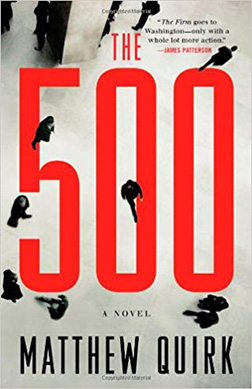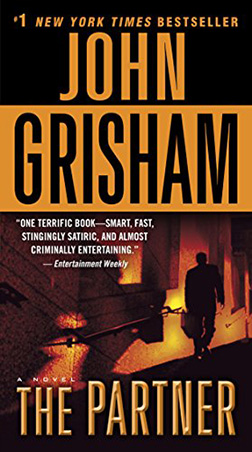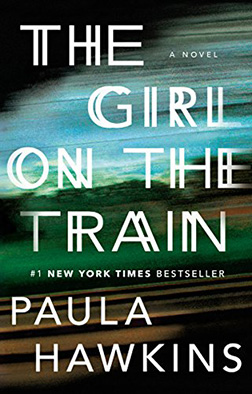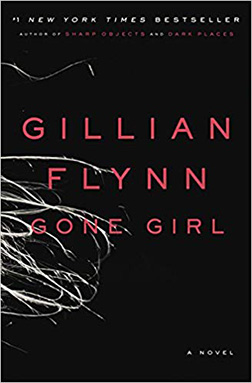
s a huge fan of the genre, I devour thriller novels with impressive twists. Creating twists that surprise, entertain, and satisfy the audience without causing plotholes or using deus ex Machinas is no easy feat. It takes creativity, planning, and hours of writing and rewriting.
If you’re a thriller writer stuck on your next work or can’t find an idea that excites you, studying thrillers you’re a fan of is bound to ignite the inspiration you need. I picked my favorite twists from four thrillers. I (re)read these books at lightning speed, envied the writers’ imagination and skill, and learned quite a few lessons on how to pull off even the most insane twists. (To get the best experience from this article, I recommend reading the books in their entirety. And since I’ll feature many spoilers, you might want to return to the article after reading: The 500 by Matthew Quirk, The Partner by John Grisham, The Girl on the Train by Paula Hawkins, and Gone Girl by Gillian Flynn.
“The twists don’t need to be shocking. Quality and consistency beat shock and outrageousness.”
The 500, Matthew Quirk

Promising Harvard law student Mike Ford has a shady past thanks to his father and brother, but he’s worked hard to leave it behind. Guest-lecturer Henry Davies, owner of the lobbying giant Davies Group in Washington, hires Mike as his newest junior associate. Despite the tremendous life the firm offers, Mike realizes Henry and his firm are more criminal and dangerous than his past.
Twists:
- Just how evil Mike’s boss Henry is! You might think you are prepared for dirt, corruption, and blackmail, but Henry has no limits.
- The firm is after a judge who knows Henry’s violent secret. However, he might be the only incorruptible man in town.
- Irin, the daughter of a Colombian war criminal and Henry’s client, tries to seduce Mike, and we think she is working for Henry or has an angle of her own. But she’s working with the judge.
- The more dangerous things get, the more Mike suspects his girlfriend/colleague might be working for Henry. Henry probably wanted them together for leverage; she turns out to be a reliable and devoted ally.
- Mike doesn’t sleep with Irin. It would be more leverage in Henry’s hands. But Mike doesn’t stray.
- Mike’s dad wasn’t guilty of the crime that sent him to prison for sixteen years. He was protecting his wife.
- Henry’s men kill the judge and Irin, framing Mike. He has to run.
- The proof Mike is after, the proof that will send Henry to prison, gets burned down. Mike barely escapes.
- Henry’s man Marcus kills Mike’s father. Except he doesn’t—the dad and an old friend fake it, so he can get away from Marcus. But for a short while, we, including Mike, believe he dies.
- Irin’s father and his men kidnap and torture Mike to avenge her death, intent on killing him. Mike proves it was Henry and uses the father’s men to take his boss down for good.
What You Can Learn From This as a Writer:
The beauty of Quirk’s twists is their simplicity. They aren’t jaw-dropping. They are logical, somewhat expected, and welcome. Because his characterization, plotting, and pacing are consistently brilliant, the twists don’t need to be shocking. Quality and consistency beat shock and outrageousness in this debut novel, and you can do the same in yours.
The Partner, John Grisham

Patrick seemingly had everything going for him: a partnership at a prestigious law firm, beautiful wife, and baby daughter. But when 90 million disappears from the firm after Patrick supposedly died, a year-long manhunt begins. When Patrick is caught, the state wants the death penalty; someone burned in that car instead of Patrick. Feds want the money back. Surely, Patrick can’t get out of this? But as everyone soon finds out, Patrick has planned everything, and he has good reasons to do what he did.
Twists:
When Patrick “died,” an insurance company paid his wife life insurance. Another insurance company paid 4 million dollars to the law firm he worked for, so they could pay the client whose 90 million he stole. So, the client and the insurance companies hire a private investigation firm to capture Patrick. When he’s caught, he’s tortured within an inch of his life. But Patrick’s prepared:
- His girlfriend Eva, a smart Brazilian lawyer he met while on the run, is the only one who knows where the money is. So Patrick won’t be able to give them the money even if he wants to. He gives them her name, though.
- As planned, Eva disappears after Patrick’s capture. But she first calls the FBI and tells them who has Patrick. She knows which firm is behind this. So the firm’s boss is pressured to surrender Patrick to the FBI. This saves his life.
- He is taken to a military hospital because of the severity of his wounds. Here, he makes sure his photograph is taken. He also befriends the doctor and stays in the hospital for weeks due to his state.
- Eva hires an old lawyer friend of Patrick’s to represent him. They use the hospital photos to countersue the FBI, so they can get the FBI to apply more pressure on the firm that captured Patrick.
- Upon Patrick’s return, the insurance company wants the money back from his wife. She and her shady boyfriend aren’t above killing Patrick to keep the money, and she’s cunning enough to pin it all on the boyfriend. Patrick’s lawyer warns the sheriff about this, and they talk to both the wife and boyfriend about it, assuring Patrick’s safety.
- Patrick’s wife files for divorce. Patrick sends his lawyer to their smug divorce attorney. The wife is also on TV, giving interviews and gaining sympathy. But she was cheating on him the whole marriage, and the daughter isn’t his. He has proof. She is granted a divorce and custody, but she’s banned from talking to the press and has to forego any rights on Patrick’s assets. Patrick also assures the girl’s future will be secured through a fund that only allows expenses on her education.
- The investigator, whose men caught Patrick, testifies in front of the FBI, admitting he was hired by the law firm’s client and the insurance companies. Patrick’s lawyer drops the suit against the FBI and gets the firms to back off from their claims on the money. After all, they tortured him; it is recorded; and they will be in big trouble. Also, the lawyer makes sure the life insurance paid to the wife isn’t taken back, further assuring Patrick’s safety.
- With the proof Patrick provides (hours and hours of recorded tape), they prove the client who lost 90 million was defrauding the government to begin with—and Patrick’s old firm was in on it. Patrick agrees to pay the money back to the government with a little interest, and the Feds drop charges to go after the big fish. Even after Patrick pays the money back, he is still a rich man, as he had invested, with Eva’s help, and lived modestly until he was caught.
- Patrick’s still facing the death penalty, but there is no body. Patrick proves that the body in his car was already dead. It was the body of a friend whose will Patrick was taking care of. His lawyer pays a sum to the family who wasn’t close to the man. In return, they ask the state to drop the case, and they won’t testify in court. The deal reached is that Patrick’s only charged with mutilating a corpse, and time served. Patrick is a free man.
- Thanks to Eva providing all the help to the lawyer while in hiding, Patrick is now free. He is set to meet the love of his life.
- But Eva doesn’t show up, neither does the money. Patrick goes back to his modest life in Brazil.
What You Can Learn From This as a Writer:
John Grisham provides a balance between us rooting for the wronged and cheering for revenge while making us question why Patrick goes as far as he does. His semi-happy ending is both appropriate and welcome, though several readers felt robbed by Eva’s disappearance. She protected him throughout and saved his life again and again. But then, it is easy to like and understand her. She had to leave a perfectly happy and safe life to be with him.
The novel is a solid example of creating likable, relatable, interesting, and flawed anti-heroes. Patrick is the ultimate anti-hero. Besides being likable, he has his weaknesses, and he goes to extreme lengths to start a new life and take revenge. Yes, the firm was going to fire him after the money. Why not just expose them without stealing the money? He was fully prepared to run away had his plan to steal not worked. Why not get a divorce? He already had the proof to protect all his assets. Then he wouldn’t have exposed his friends to the pain. And with this type of brilliance, why not get a job at another, better law firm? Or set up his own company?
What the author does in this novel is inspiring. This means you don’t have to create an either/or ending. Not all your readers will like an “unhappy” ending. But if you switch it up in your various books—between happy, sad/shocking, and bittersweet endings—your readers will appreciate being kept on their toes.
“A fresh and tight story gives you more license to create less likable characters.”
The Girl on the Train, Paula Hawkins

Rachel is a divorced alcoholic staying with a friend, lying about going to work and hung up on her ex-husband Tom. Rachel is still upset about not being able to have a baby, and it hurts to know Tom lives in their old house with his new wife (Anna) and baby. Anna is the realtor who found them the house, and he cheated on Rachel with her.
Rachel gets on the train every morning and watches people. She is fascinated by a young, beautiful married couple. She fantasizes about them having the ultimate relationship until she sees the woman with another man. Then the woman, Megan, disappears, and Rachel wakes up with memory loss and a bloody sweater.
Rachel is an unreliable narrator. Because she drinks and suffers from blackouts, even she doesn’t trust herself. So when Megan disappears, Rachel decides to figure out what happened. We also have two more narrators, Megan and Anna, who provide the details Rachel can’t know.
Rachel introduces herself to Megan’s husband as a friend and tells her about the man. Being the suspicious type, the husband immediately suspects Megan’s therapist. Rachel confirms it, and the police look further into him. But he has an alibi, and he shares his own concerns about the husband.
Twists:
- Rachel starts seeing Megan’s therapist under the guise of recovering her lost memories. She also stops drinking.
- Through Rachel’s eyes and memories, Tom is portrayed as a flawed but mostly semi-decent guy. But as Rachel remembers and talks to people, we realize Tom was abusive, and he was gaslighting her. Rachel was never violent.
- Megan’s corpse is found in the woods, and Rachel is a suspect.
- The therapist wasn’t sleeping with Megan.
- Megan worked as Anna and Tom’s babysitter, and she was sleeping with Tom. Anna finds out.
- Megan was pregnant with Tom’s child. She refuses to have an abortion, and Tom kills her.
- When Rachel figures out Tom’s the killer, she goes to warn Anna. She provokes Tom, and Anna sees just how dangerous Tom is. Tom tries to kill Rachel, but Rachel almost kills him in self-defense. Anna makes sure he dies.
- Anna collaborates Rachel’s story to the police.
What You Can Learn From This as a Writer:
The Girl on the Train uses the genre’s, plot’s, and characters’ potential to keep us guessing at what is happening, and this book is basically a crash course in crafting well-done multiple and unreliable narrator(s). The three narrators also provide a broader perspective and faster pace.
Megan’s husband especially makes a great suspect with his temper. If the therapist were sleeping with his patient, he would have a motive. We suspect Rachel because she believes she hit someone and had an altercation with Anna, not Megan. We don’t have a reason to suspect Tom until we find out about the affair and his true nature; but by then, we are on the edge of our seats. And after we realize the truth about Tom, we are dying to know if Rachel will be able to save herself, Anna, and the baby. We aren’t sure who Anna will side with until the last minute. Gillian Flynn shows that a fresh and tight story gives you more license to create less likable characters such as these.
“One key to creating believable twists and character actions is that you have a logical explanation for everything.”
Gone Girl, Gillian Flynn

Nick has uprooted Amy, his wife of five years, to his hometown to care for his ailing mother. Here, he runs a bar with his twin sister, which was paid for by Amy, and teaches at a local college.
When Amy disappears, their house looks like there was a struggle. The more the police investigate, the more it seems like Nick killed his wife: The scene was staged; a lot of blood was spilled and haphazardly cleaned. Nick doesn’t seem to know or love his wife. Police find extravagant credit card purchases. He was having an affair with a student. Everything is in Amy’s name; and if they get divorced, she can claim the bar. She has tried to buy a gun. They find a diary, in which Amy depicts their entire relationship, from the rosy start to the abusive last days, where she fears her husband. Amy was pregnant, and Nick didn’t want the kid.
Nick looks so guilty that he hires a brilliant lawyer who specializes in freeing guilty(-looking) husbands. And while the evidence piling up against Nick are twists in their own right, the really jaw-dropping ones come after we switch to Amy’s point of view—not the diary entries, but what really happened.
Twists:
- Amy did this. She planned everything to frame Nick to frame him for her murder, and Missouri has the death penalty.
Most of Amy’s diary is accurate, so Nick looks like he’s denying the bits that don’t serve him. She was never abused, but she was furious at Nick for being a cheat and a lousy husband. When they met, they both pretended to be other people. However, when they both lost their jobs and Amy’s parents had to take back most of her trust fund, Nick quit pretending. She never forgave him for the move from New York either.
- The diary is fabricated: Seven years of entries, a part of Amy’s plan.
She was going to kill herself; she changed her mind later.
- When she is hiding, all her money gets stolen, so she has to ask for help from her obsessive ex, Desi. Desi doesn’t just give her money; she has to go to his secluded lake house—where he controls everything.
- Amy kills Desi to return to Nick.
While trying to get the public to see him favorably, Nick makes sure that Amy can see the effort he is making. He apologizes, owns his faults, and professes love. Since this is the Nick whom Amy wanted, and Desi turns out to be a worse option, she kills Desi. But first, she makes sure she is caught on tape, as an abused victim trying to get away. She harms herself to fake rape and being held hostage. She sleeps with Desi before killing him, so that she has enough proof.
- She returns to Nick in front of cameras. She blames the entire thing on Desi and adjusts her story accordingly. At this point, the FBI is willing to shut it down.
- Nick wants to leave her, but she never admits to anything when he could be wearing a wire.
- She gets pregnant; it’s Nick’s.
- She writes a book to tell her story and demands Nick to confess to the parts of her story that don’t add up. If he doesn’t, he won’t see his child, and who knows what allegations she will throw his way.
- He agrees to stay with Amy and raise the kid together, as he pretends to be the guy at the beginning of the relationship. And his twin sister is shocked that he does want to stay with Amy.
What You Can Learn From This as a Writer:
Gone Girl’s success lies both in the story and how it is told. The story is so gripping and chock-full of shocking (but earned) twists that we don’t care the characters are horrible or unlikable people. The diary entries throw us off, and we don’t have a reason to suspect Amy in the beginning. Even when we suspect Nick is innocent, he is unlikable enough that a part of us roots for Amy.
One key to creating believable twists and character actions is that you have a logical explanation for everything. Gillian Flynn gives us the point of view of both Amy and Nick, so we learn the ins and outs of both of them. By the end of the book, we know both so well that we want the smarter person to win, and it’s clearly Amy. Keep your characters strong and consistent, even if they are horrible people!
*
The key to writing a great thriller is to analyze what matters to you in your favorite books and experiment with your story until you are satisfied. Have fun creating pages that thrill your audience!

Pinar Tarhan is a freelance writer, screenwriter, novelist and blogger. Her bylines include The Washington Post, Popsugar, The Billfold, Horkey Handbook, and WOW! Women on Writing among others. She’s recently released Making a Difference (M.A.D.), her first novel—a fun, contemporary romantic comedy set in New York.